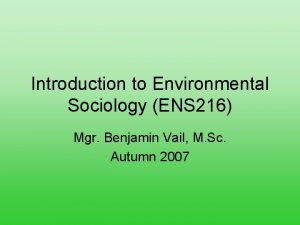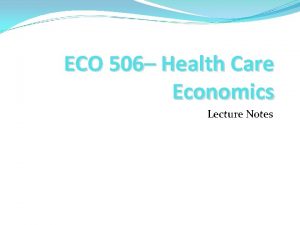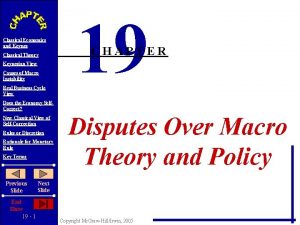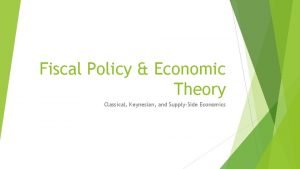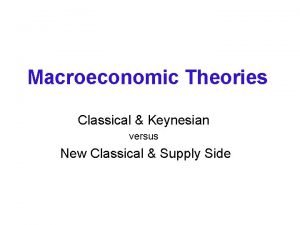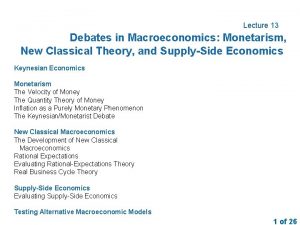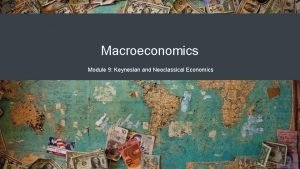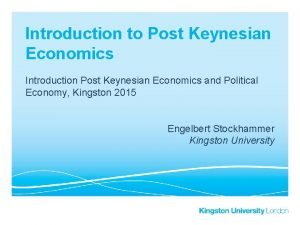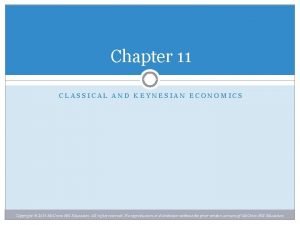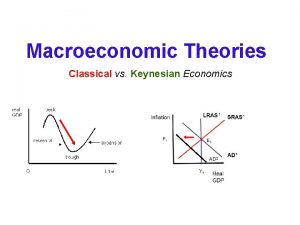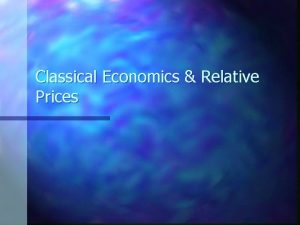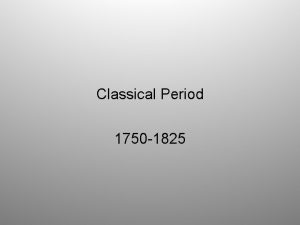Neo Classical to Environmental Economics Lecture 7 Neo



















- Slides: 19

Neo Classical to Environmental Economics Lecture 7

• Neo Classical view – No limit to growth as technology can take care of all those factors which may come in the way of growth • Environment is only a sub component of economy – only role it plays is - source of economic growth and sink of unwanted economic by products • Human (man made) capital can replace natural capital • Over emphasis on the role of market – all human desire can get reflected in the market!

Neo Classical View • Neoclassical economists argue that the free-market system can attain the best possible allocation of resources through individuals acting in their own best interests and without government regulation. • Mainstream economic theory has tended to assume that economic systems were independent of environmental restraints and therefore these could be ignored. • At best environmental pollution was treated as an externality that occurs when production or consumption by a firm or consumer directly affects the welfare of another firm or consumer and those causing the damage are not financially accountable for it. • Externalities, whilst examples of market failure, were not considered to be significant flaws in the market system, although Arthur Pigou had advocated government intervention in the form of taxes and subsidies to discourage externalities.

Environmental Degradation • Fossil fuel is the most important production input to run the economy and for the society also. • According to the famous Hubbert curve, in 1912 only 2 billions of barrels of oil was discovered; in 1960 it touched a peak of 40 billion barrels per year; but during 1990 s, it fell to 6 billion barrel per year (Daly and Farley, 1994). • On the contrary, consumption of fossil oil reached 26 billion barrel per year exceeding the rate of discovery by 2 -4 times (Daly and Farley, 1994). • Minerals are also extracted from the topsoil. • Rates of topsoil depletion in the U. S. A. is 100 times more than the rate of its formaton. • Water is very important ecosystem which performs many servicesdrinkng, irrigation, and waste disposal. Global consumption of water over last 50 years (1960 -1910) has tremendously increased. Currently about 11% of the world population has no access to improved drinking water sources (UNEP, 2013). In percentage though this is a small figure, in numerals it is about 783 million people!

• Other renewable resources like forests and soil are also depleting. • 84% of the wetlands which performs the sink service of the environment are threatened. • According to the Statistical Yearbook for Asia and the Pacific 2007, in the ASEAN (Association of Southeast Asian Nations) countries, forests covered has declined to 47% in 2005 from 56% in 1990. The land area covered by forests decreased by 16% points in Indonesia, 14% points in Cambodia, 11% points in Philippines, and 10% points in Myanmar.

The concern for Environment • These concerns touched international dimensions only during 1950 s. • And gathered momentum during 1960 s with the publications of paradigm-breaking books and articles like Rachel Carson’s “Silent Spring” (Carson, 1962), Garrett Hardin’s “The tragedy of the commons” (Hardin, 1968), etc. • At the end of the 1960 s, the voice of environmental concerns was heard almost uniquely in the West, where there were (and, to some extent, still are) two principal schools of thought (UNEP, 2003) about the causes of environmental degradation: one school blamed economic growth; the other blamed population growth.

Rachel Carson’s “Silent Spring” • The first environmental revolution was initiated by Rachel Carson’s Silent Spring in 1962. • She worked for awakening people about the harmful effects of pesticides in agricultural fields • Carson’s warnings about the effects of agrochemicals (DDT, Pesticides) in the environment were not new, but they were cogently put and had already gained public attention earlier in the same year with a series of three articles in the New Yorker. • That economics should have a lot to do with environmental concerns of the kind raised by Carson was not surprising.

• First, agrochemicals were and are big business. • Second, the use of chemicals such as DDT had done a lot to raise agricultural productivity and protect human health. • Third, economists were already familiar with the idea that there are likely to be costs and benefits from any form of economic activity. • The costs take the form of “external effects, ” in this case the alleged loss of biological diversity about which people had begun to care far more than previously

The tragedy of the commons (1968) • The tragedy of the commons occurs when individuals neglect the well-being of society (or the group) in the pursuit of personal gain. For example, if neighboring farmers increase the number of their own sheep living on a common block of land, eventually the land will become depleted and not be able to support the sheep, which is detrimental to all.

The Limits to Growth • A report called “The Limits to Growth” was published in 1972 by the Club of Rome. • Using sophisticated computer simulation model, the authors Meadows et al. focused attention on depletion of non-renewable resources and resulting increase in commodity prices. • The report was about to search for a model output that represents a world system that would be sustainable without sudden and uncontrollable collapse; and be capable of satisfying the basic material requirements of all of its people (Meadows, 1972). • The report considered non-renewable resources.

IPAT: IMPACTS, POPULATION, AFFLUENCE AND TECHNOLOGY – NEO MALTHUSIAN APPROACH

The neo-Malthusians and the Kuznets Curve • The neo-Malthusians had their origins in the late 1960 s and early 1970 s, when books like The Population Bomb (Paul Ehrlich) and The Limits to Growth (the Club of Rome) were published. • Their main premise was different than Malthus’s doomsday omen, it was more focused on environment degradation: The richer people get, the worse things become for the earth. • The neo-Malthusians see impending disaster: air pollution, the disappearance of habitats, the emptying of aquifers, the demolition of forest cover, and the proliferation of new diseases.

• The neo-Malthusianism have consistently underestimated the beneficial effects of technological change. • Three decades ago, Paul Ehrlich and John Holdren invented the angular stone of the movement: • Environmental impact (I) = population size (P) times level of affluence (A) times technological efficiency (T)

• This means that technological change has a multiplier effect on population size and the wealthiness of the population, so we need to place strict limits on human behaviour. • There is some logic on this theory: “As societies get richer and more populous, they do consume more resources, and, especially in the early phases of economic growth, they do so with a measure of indifference to the overall impact on the environment”(J. Surowiecki). • But the flaw in the equation is that technology can also reduce environmental impact. • Technological change is actually the result of increased affluence, which makes it likely that an economy will get cleaner even as it gets richer, • Because technology first evolves to increase production output, and then evolves to efficient that output. This is what as we discussed is the environmental Kuznets curve (EKC)

• Initially, as countries grow, they trade off environmental well-being for economic growth; the richer they get, the more polluted. • Then a wealth’s critical mass is reached, basic needs are met, and, according to Maslow’s hierarchy of human needs, the concern goes to non-basic needs, like a better environment. • People have the time to form NGOs and to push for cleaner industry, and technology is serving efficiency instead of brute production. • The economy becomes prosperous enough to shift their priorities and begin to seek out ways to grow more cleanly • Richer countries open the path to poorer ones, since the invention and spread of new technologies make it easier and more likely for countries to get on the right side of the U-curve quickly, even before they have become rich

• So we can modify the neo-Malthusians formula distinguishing between technology for mass production (P 1) and technology that efficient the production process, having less waste and yield (P 2): • I = PAT 1/T 2 • The turning point of the EKC will be when PAT 1<T 2 • In order to embark on sustainable path and reduce GHG emissions and other human impacts on the environment , some contribution has to come from RHS of the equation, namely stabilising population, constraining meterial growth and / or adopting environmentally friendly technologies

Growth of Environment Economics • In the 1950 s, a group of economists started to take the environment more seriously. Resource economists sought to develop models of how industries that relied on environmental resources, such as fisheries, forestry and agriculture, could use them in an efficient and optimal way (Spash 1999). • Resources for the Future (RFF) was established in 1952 following the publication in the USA of the Paley Report about the potential exhaustibility of resource (Pearce 2002). • “Source problem”

Growth of Environment Economics • Environmental economics emerged in the 1960 s as public concerns with environmental pollution grew. • Limits to markets due to the constraints of nature were recognized, in particular the indivisibility of nature that inhibited the allocation of property rights to many environmental benefits. • Economic modelling expanded to cover resource depletion and pollution. • “Sink problem”

Growth of Environment Economics • The recognition of market limitations began to fade in the 1980 s. • Today environmental economists believe in the power of the market to allocate environmental resources efficiently and in a socially optimal way, just as it does with economic products. • To achieve this, environmental goods, services and amenities need to be given a price so that they can be incorporated into the market. • If people and firms are charged real prices for using the environment, environmental considerations will be incorporated into market decisions. • The solution to environmental problems is therefore to ensure that the environment is properly priced to reflect the relative scarcity of natural resources and assets.
 Neorealizm ne demek
Neorealizm ne demek Characteristics of neoclassic art
Characteristics of neoclassic art Characteristics of neoclassicism
Characteristics of neoclassicism Neoclassical organization theory
Neoclassical organization theory 01:640:244 lecture notes - lecture 15: plat, idah, farad
01:640:244 lecture notes - lecture 15: plat, idah, farad Environmental sociology examples
Environmental sociology examples Land economics lecture notes
Land economics lecture notes Health economics lecture notes
Health economics lecture notes Principles of economics powerpoint lecture slides
Principles of economics powerpoint lecture slides Monetarist vs classical economics
Monetarist vs classical economics Classical economics vs keynesian
Classical economics vs keynesian Keynesian vs classical vs monetarist
Keynesian vs classical vs monetarist Monetarist vs classical economics
Monetarist vs classical economics Monetarist vs classical economics
Monetarist vs classical economics New classical macroeconomics
New classical macroeconomics Classical economics vs keynesian
Classical economics vs keynesian Keynesian policy
Keynesian policy Keynes law
Keynes law Classical economics vs keynesian
Classical economics vs keynesian Mh 605
Mh 605





